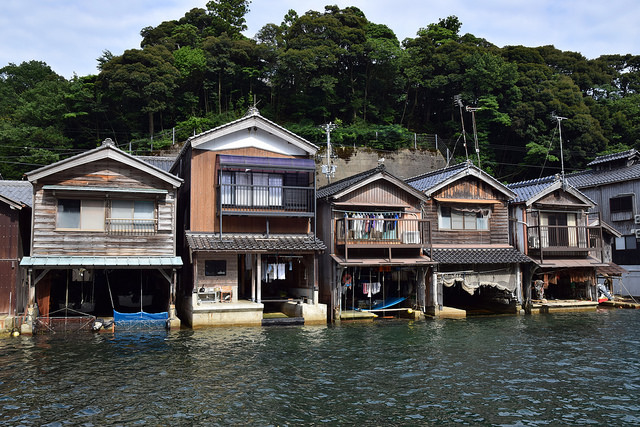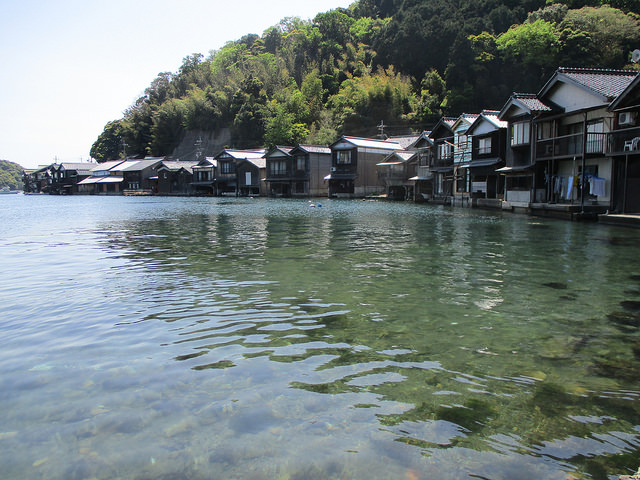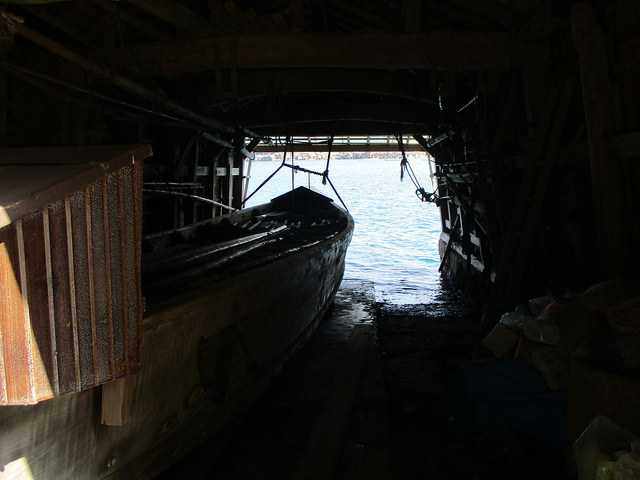
photo by Raita Futo
Located at the northern region of Kyoto prefecture, on the east of Tango peninsula poking into the Japan Sea, there is a little bay making gentle curves on the calm water. It is just a distinctive Japanese fishing village on Ine bay, its water is calm throughout the year, surrounded by a range of low hills right behind it. The little houses with gable roof are standing squashed next to each other by the sea. These houses that look as if they are standing over the sea water, are called “Funaya of Ine” and have been a popular tourist’s spot since the old times. This place has totally different atmosphere from the ancient metropolis “KYOTO”. Ine is where you can experience traditional Japanese lifestyle in the relaxing time stream.
What is the Funaya of Ine?

photo by Tommy1969
About half an hour drive from one of the Three Views of Japan, Amanohashidate, Ine is an old fishing village still known for tourism and a fishery industry. Among others, a group of old fisherman’s houses called the Funaya of Ine, which look as if they are standing in the water, are recognized as rare construction unique to this township. A house with a pointed roof called a gabled house is standing with its gable wall facing the water. The first floor of the house is used as a work area and a storage, and the second floor is designed to be used as a residential area. The Funaya of Ine was certified as an Important Preservation District for Groups of Traditional Buildings in 2005 for being a valuable scenery that shows the view of a few hundred years ago in 21st century. Thanks to Aoshima, that is sitting in the open end of the bay and working as a breakwater, the sea water of Ine bay is calm throughout the year. Here is a hidden sightseeing spot where you can enjoy the scenic collaboration of the view of historical fishing village and seasonal background views. This place has often been used as a filming location of movies and TV drama series for the fantastic sceneries.
Fishing from the window of the house?

photo by Tommy1969
The second floor of Funaya was used as a work area or a residential are before, but recently, some of funayas have been renovated inside and used as an inn. During summertime, the guests are often spotted swimming in the seawater directly from the first floor of funaya. As you can see by seeing some of pictures, steep hill are surrounding right behind of Ine bay. The hills steeply slopes into the sea, therefore the water of Ine bay quickly deepens and there is no seashores around the bay. Some of bank protection works have been done in late years and the water right in front of house are not very deep. But once you go a little far in the sea, the water easily gets about 20m of depth and there used to be dolphins and whales wondering off into the bay. Such a geological formation and the becalmed water makes Ine bay a perfect fishing spot. Fish generally appear just around funayas, then some of inns let their guests fish from the guest room window. Greenlings in winter and flatheads in summer are best captured in Ine bay. Just chilling out and seeing a fantastic view from the window while you are waiting for a big one take a bite on your hook, wouldn’t it be nice?
Tourism in Ine
Ine Bay Boat Tours
A tour on a sightseeing boat letting you overview a 5km long of funayas lining along Ine bay. The tour starts from the west end of the bay and runs about 25 minutes. After the boat passes Aoshima, the first landmark in Ine bay, breathtakingly photogenic scenery lies ahead right in front of you. Also, you can enjoy feeding seagulls from the deck of the boat. This is a great opportunity to have glorious view of the Funaya of Ine from the sea.
Ine Bay Boat Tours
Tour launches every 30minutes 9:00 – 16:00
Fees: Adult JPY680, Child JPY340
Guided tour around Ine’s funaya and mondori experience
Experience genuine life style in funaya with a local guide. In addition to a tour in funya, this tour is full of new discoveries including a unique fishing method called “mondori” that is used by locals to catch fish for their everyday meals, and sake tasting at the local sake distillery. This event is open from spring time to the end of November and gaining great popularity from tourists. In this 90minutes of tour, you will know everything about funayas. Bookings required.
Guided tour around Ine`s funaya and mondori experience
Fees (Tour in English): Adult JPY3,000, Child (Elementary school students) JPY1,800
Ine’s local gourmet festival
It is called “Umya-mon” festival, meaning good foods in indigenous speech of the area, and held around October every year. Ine’s fishery products, farm products and other local foods are sold in many stalls. The highlight of the event is a tuna cutting demonstration. It is worth taking this rare opportunity to see a trained professional’s knife works.
Kyoto Prefecture Tourism Guide
Kyoto is not just about temples and shrines
The Funaya of Ine, the houses that have been intimately related to the lives of local people since centuries ago. Historical temples and shrines in Kyoto city might be the first thing about Kyoto comes up to your mind, but there also is such a beautiful spot in a little fishing village by the Japan Sea. Close to Amanohashidate, one of the Three View of Japan, this place is a perfect spot to drop by after visiting Kyoto city. Why don’t you have a look these unique constructions and learn the traditional genuine lifestyle of Japanese people.
